In another installment of my chocolate ingredients series, this primer on cocoa butter is a deep dive into one of the most important ingredients in chocolate: cacao fat. This lipid, called interchangeably both cocoa butter and cacao butter, is a plant-based source of both saturated and unsaturated fat (meaning that cocoa butter is vegan, indeed).
But these days cocoa butter is getting a bad rap in food & a good one in cosmetics. So which is it? To put some of your fears to rest, this concise guide to cocoa butter addresses all the most commonly-asked questions about cacao butter benefits & concerns.
In fact most questions surrounding cocoa butter fall into one of two camps: eating it as dark chocolate or putting it on your skin. From its origins and uses to health effects both positive & negative, cocoa butter is both delicious and complex!

Jump To
What is Cocoa Butter?
Most simply, cocoa butter is the fat of the cacao bean, which is actually the seed of the tropical cacao tree, native to South America. Cocoa butter— also called cacao butter— makes up roughly half of the cocoa bean's weight, with cocoa grown further from the equator containing a higher percentage of cacao butter.
So is cocoa butter vegan? Why yes indeed! Despite the confusing name (much like the misleading 'chocolate liquor'), cocoa butter is vegan-friendly and incredibly delicious.
Even though cocoa powder gets all the attention for its chocolaty flavor, without cocoa butter, your chocolate would lack the creamy, melty consistency we all associate with our favorite chocolate bar. In fact, all cocoa powder contains some percentage of cocoa butter. That's because it's physically impossible to press out all the fat from cocoa beans.
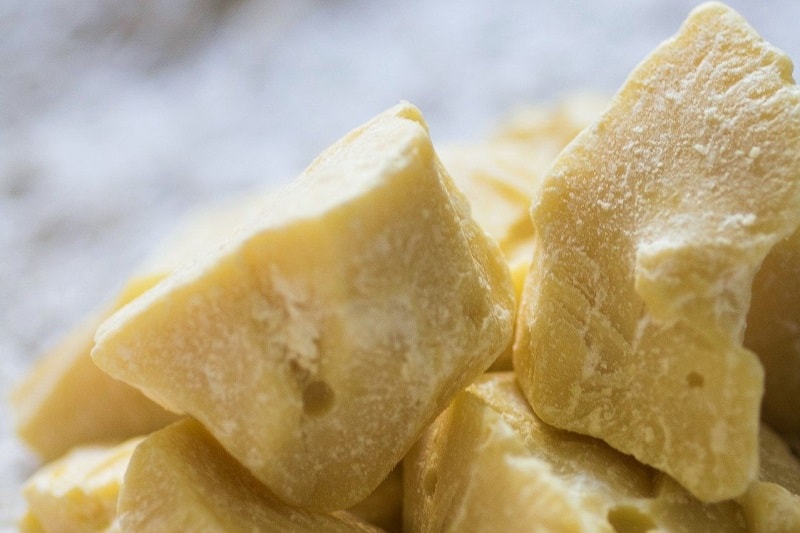
To produce cocoa butter, cacao beans are ground into a paste. Then the paste is pressed with a very strong weight, forcing the fat to ooze down the sides and collect below. Even with the strongest of weights, however, most commercial varieties of pure cocoa powder still contain roughly 10% fat.
The rest of that cocoa butter is generally sold into the cosmetics industry, as cocoa butter is highly valued in the skincare market (but more on that later). In craft chocolate, however, when you find a cocoa powder pressed by the makers themselves, it usually means that the fat percentage— amount of cocoa butter— will be much higher, around 20%.
This is because their pressing equipment usually can't exert the pressure required to extract more of the fat. But this increase amount of cocoa butter has another dual purpose: flavor and mouthfeel. It's also responsible for setting oil-based chocolate stains.
As they always say in cooking, the fat carries the flavor, so higher-percentage cocoa powder will be more aromatic and flavorful than lower-fat ones. So when you're baking with chocolate, always be sure to use high-fat cocoa powders to take advantage of the health benefits of cocoa butter.
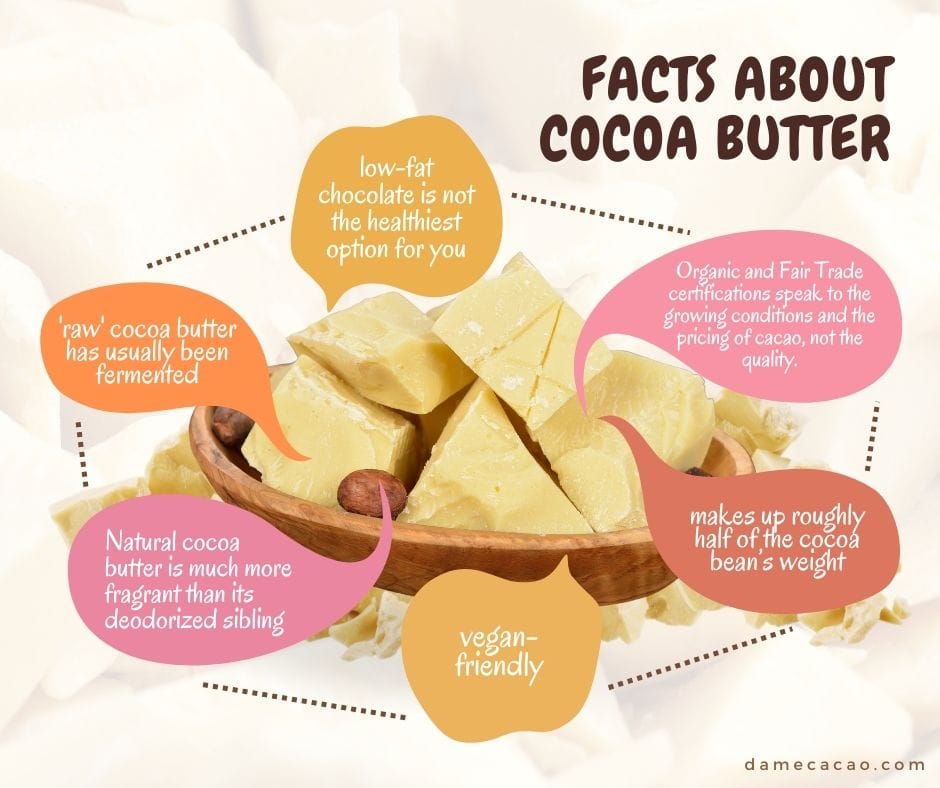
How is Cocoa Butter Made?
Cocoa butter is made by pressing the seeds of the cacao tree until the cacao fat and the cacao solids separate. Usually the seeds are first fermented, dried, roasted, and peeled before being ground and pressed for cocoa butter.
In the old days, cocoa butter said to have been first separated from the solids with the invention of Coenraad Van Houten's cocoa press, patented in 1828. The machine solely makes use of pressure to separate most— but not all— of the cocoa fat from the cocoa solids.
This allows for both chocolate cakes and low-fat chocolates to be made from the remaining solids, as well as foods and cosmetics to be made from the cacao butter. Raw cacao butter is said to be the best for such applications, but the health benefits of raw cacao butter vs. cocoa butter pressed from roasted beans is negligible.
Most small craft chocolate makers simply cannot afford the expensive cocoa butter presses needed to make their own cacao butter, so most of them buy cocoa butter to add to their bars. This doesn't change the flavor much, but it's important to make sure that only pure cocoa butter is added to chocolate, rather than some random vegetable oil.

Myths About Cocoa Butter
Here's a quick review of the common myths about cocoa butter and chocolate.
Myth: Raw cocoa butter is better for you.
Fact: There's no such thing as raw cocoa butter! Cacao butter labeled as "raw" is more likely unroasted cocoa, but is almost certainly fermented, which would bring the mass temperature well above the typical "raw" limit of 118°F/48°C. Most importantly, however, the word "raw" has no legal definition in food.
This means that any company that wants to could call their cocoa butter raw, natural, and premium; no matter where it comes from or how it was processed.
The myth of raw cacao butter benefits has persisted for too long. High quality cacao butter comes from high quality cacao pressed by trusted sources, like your local craft chocolate company, and fermentation and roasting do not degrade the quality of cocoa butter.
Myth: Organic, Fair Trade cocoa butter is the highest quality you can buy.
Fact: Organic and Fair Trade certifications speak to the growing conditions and the pricing of cacao, not the quality. The only way to buy high quality, ethical cocoa butter is by buying directly from a chocolate maker or cocoa processor you trust, like your local craft chocolate maker or a processor like Meridian Cacao. Read more in this article on white chocolate.
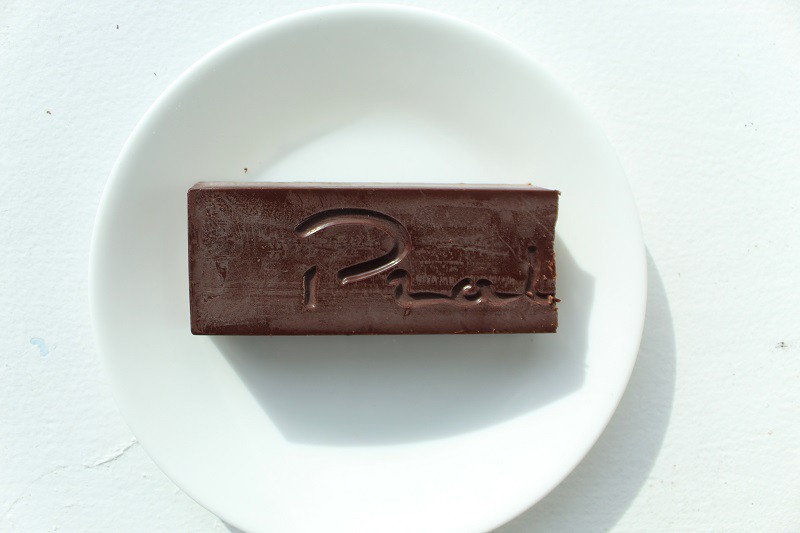
Myth: Deodorized cocoa butter is better than nondeodorized cocoa butter.
Fact: Natural cocoa butter is much more fragrant than its deodorized sibling, and sports a pale yellow or brown hue. Similar to alkalized vs. natural cocoa powder, deodorized cocoa butter is just natural cocoa butter (unrefined cocoa butter) which has been treated & heated to degrade certain aromatic chemicals naturally found in the cacao.
The most common method of deodorization is steam injection and then clay treatment to remove scent and color. This is great for soap or lotion makers who don't want a chocolaty undertone in their products, but if you plan to eat your cocoa butter, this can be off-putting.
Just always make sure you're buying food-grade cocoa butter if you plan to eat what you make (if you're not sure between a cacao butter vs cocoa butter, both can be food grade products).
Myth: Low fat chocolate is healthier.
Fact: Unless your body has legitimate trouble processing fat, then low-fat chocolate is not the healthiest option for you. This is because low-fat chocolates tend to be made using cocoa powder plus a lower-quality oil and more sugar to make up for the thicker mouthfeel of the bar.
Not only does this usually make people eat more of the chocolate to feel satisfied, but removing the cocoa butter actually increases degradation of the antioxidants that make chocolate so good for you.
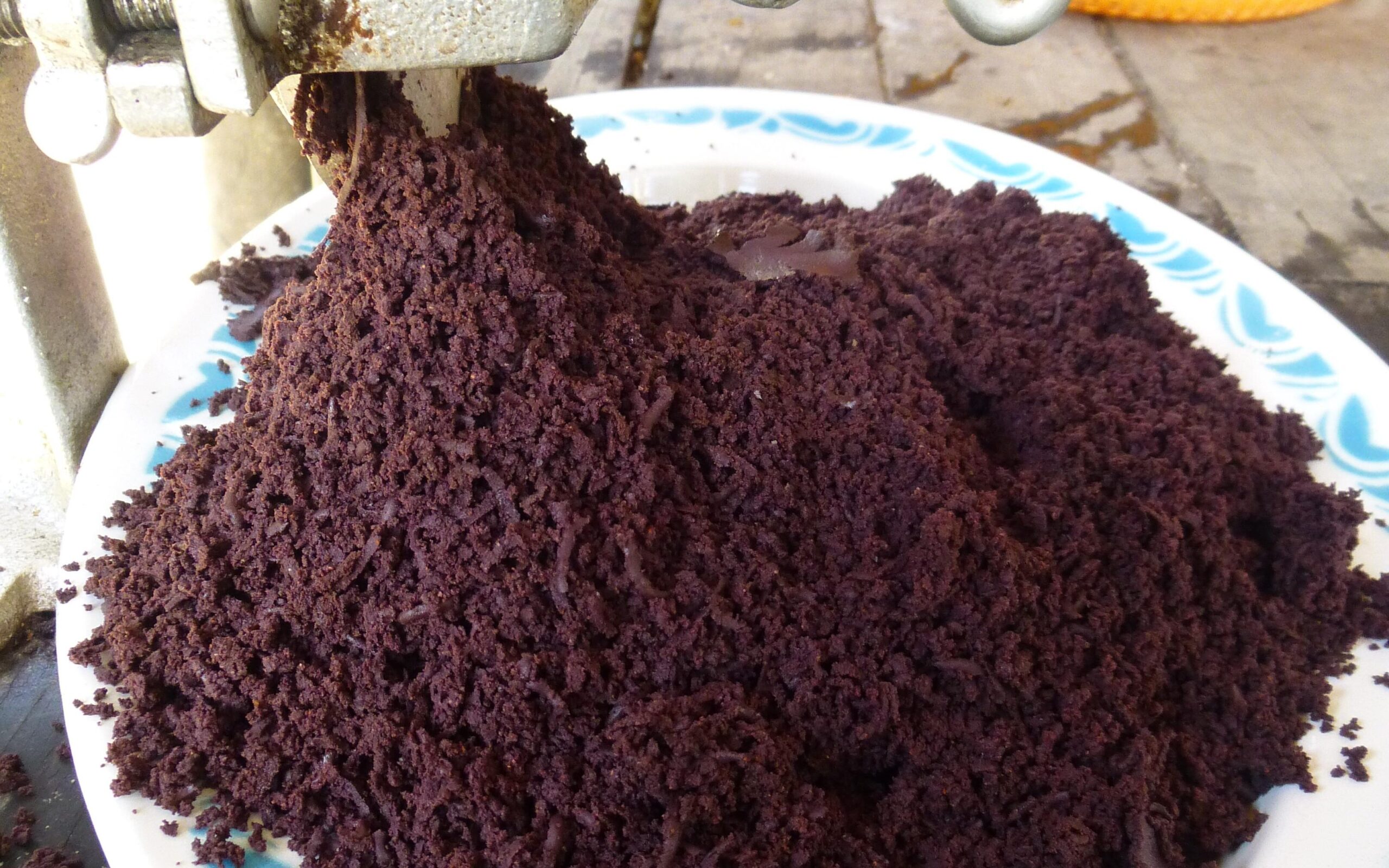
Science of Cocoa Butter
As we now know, cocoa putter is pure fat— but is cocoa butter a good fat? It's great for putting on dry skin or making body butter and lip balms, but is cocoa butter good for you?
The answer is both yes and no. This is because cocoa butter is made up primarily of four different types of fatty acids: palmitic, linoleic, stearic, and oleic. Of these four, only one is bad for your heart (palmitic acid), with the other three being either neutral or actively good for hearth health.
Cacao butter consists of approximately 25% palmitic acid, 3% linoleic acid, 37% stearic acid, 34% oleic acid, and 1% various other fatty acids, which all together melt at body temperature. So when you're eating a vegan white chocolate that's low in sugar, then it's not actually bad for your heart; though again, everything is healthy in moderation.
But back to this balance of fats, that macronutrient profile is relevant for both the health- and food-related application of cocoa butter. Not only is cocoa butter very resistant to going "bad" or rancid, but cacao's fat composition makes it perfect for retaining moisture, which accounts for its ability to help out skin smooth out the appearance of stretch marks and fade scars.
This is an interesting parallel to the role of cacao butter for the plant, as it's believed that trees located further from the equator— which naturally contain a higher-than-average proportion of fat— produce that extra fat as part of the stress response to fluctuating resources.
Yet the fact that cocoa butter makes up roughly one half of the cocoa bean is what makes cacao the perfect food for crafting melt-in-your-mouth chocolate. Plus, it's almost unheard-of for someone to have a cocoa butter allergy!

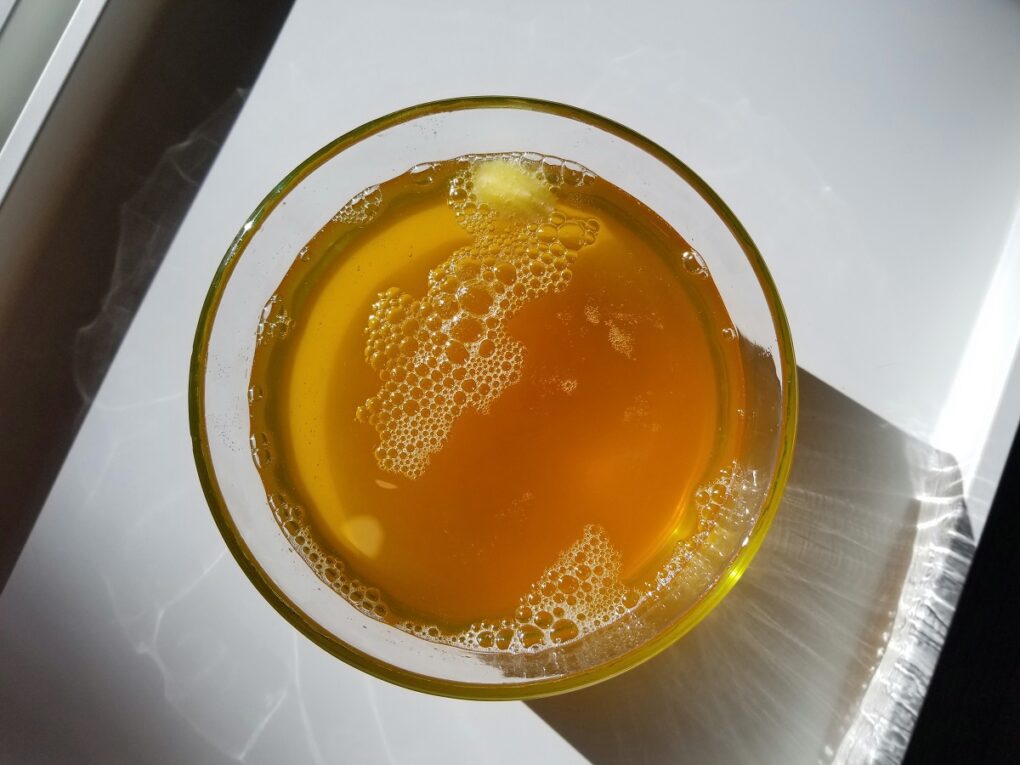
Cocoa Butter Benefits
When you think of cocoa butter, many people think first of those yellow sticks of cocoa butter from CVS or your local drug store. While those famous yellow sticks from Cococare are indeed 100% cocoa butter, they've become as famous for their scent as for their alleged effectiveness at mitigating stretch marks.
This is because one of the benefits of cocoa butter is supposed to be its effect on fading stretch marks, which has since been disproved. So what are the benefits of cocoa butter?
When it comes to eating the stuff, cocoa butter has about 45 calories per teaspoon, all of it fat. But most of this fat is the heart-healthy kind, and it has a purpose in chocolate, too. Cocoa butter actually preserves the cocoa solids in chocolate by protecting them from oxidation.
This is important because it keeps the nutrients in dark chocolate from degrading or losing their effectiveness before you actually consume the chocolate. But beyond eating the stuff, cocoa butter benefits extend to lotions and soaps made with it, as well as using it directly on your skin. While not every use for cocoa butter will be good for you, cocoa butter benefits include:
- offers mild sun protection with an SPF around 6
- roughly 75% heart-healthy fats
- high concentration of skin-protecting fatty acids
- great source of vitamin E & vitamin K
- binds ingredients due to high fat content

How to Use Cocoa Butter
There are a variety of ways to use up old cocoa butter or expand the use of it in your own homemade chocolate recipes. Some people highly prefer to make homemade vegan chocolate bars with their own equipment, while others prefer to make homemade massage oils, lotions, and chap sticks.
Similar to shea butter or coconut oil, cocoa butter is a natural moisturizer with around 6 SPF, so it even adds protection to homemade sunscreen recipes. Some people also buy cocoa butter for baking; it's great to replace part of the butter or coconut oil in a recipe.
Cacao butter can also be infused with various flavors (or even with cannabis) by being warmed at a low temperature over a long period of time (as is often done with ganache making). Cooking with cocoa butter has also become a bit popular recently, as the fat's high smoke point is great for searing meat.
I feel like I should also mention the other side of the cacao spectrum here: "the theobroma cousins of cacao;" notably Theobroma bicolor and Theobroma grandiflorum.
These two other species, which share recent roots with cocoa, are also often used in both tropical North and tropical South America for similar purposes as is Theobroma cacao. Even cacao liquor, which is made with the fresh fruit rather than the seeds, is recreated with the related theobroma species.

Cocoa Butter FAQ
While they may seem like completely different products, cacao butter and cocoa butter are indeed the same product, and an essential ingredient in both milk chocolate and white chocolate. The difference between cocoa butter and cacao butter is only in the fact that some companies prefer to use 'cacao' as it "sounds more natural."
Yes! Cocoa butter is always a vegan-friendly food— it's only when dairy or non-vegan sugar is added that you have to be careful.
Cocoa butter contains just over half saturated fats, which can more easily clog the often-delicate pores on your face, so I would not recommend using cocoa butter on your face.
While technically cocoa butter can go bad, the question of does cocoa butter go bad is that it rarely does. If cocoa butter goes bad it's generally only because it's been exposed to chemicals, had prolonged exposure to heat, or been stored for 10+ years (in any condition).
Cocoa butter comes from the seeds of Theobroma cacao, a tropical tree native to South America, whose seeds (or 'beans') are comprised of roughly 48-54% cocoa butter (fat).

















Ariel
I’m curious. You said cocoa butter “can’t” be raw. I’m inclined to disagree. Obviously it’s not raw compared to a raw carrot but the same way cocoa beans are considered raw when not roasted. Could the same not be said for cocoa butter taken from unroasted beans?
Max
Hi, Ariel! So those unroasted cacao beans are rarely actually 'raw'— see this coverage of 'raw chocolate' for more in-depth info, but even when unroasted, both the processes of fermentation and drying regularly exceed 118°F (48°C). Even for cacao which is unroasted AND unfermented (almost always because the farmers get crappy prices for their cacao, and so don't care to do this more time-consuming step in flavor development), it will still need to be dried or else it will get moldy in transit.
So even unfermented, unroasted cacao would have to be very carefully temperature-controlled in every way at origin to conform with the standard of 'raw' which people would believe they're getting. Such a venture would easily need to exceed a price of $30USD per pound for the final consumer, even if done at scale. So I guarantee you no bag of cocoa butter you can buy on Amazon is truly considered 'raw,' but there are a number of chocolate makers who press their own cocoa butter from high-quality beans, and those products will be of much better quality than anything you'd get from a 'raw foods' supply store (they themselves have a supplier, and the longer the list of middlemen involved, the lower the quality of what you buy). Hope that clarifies things.